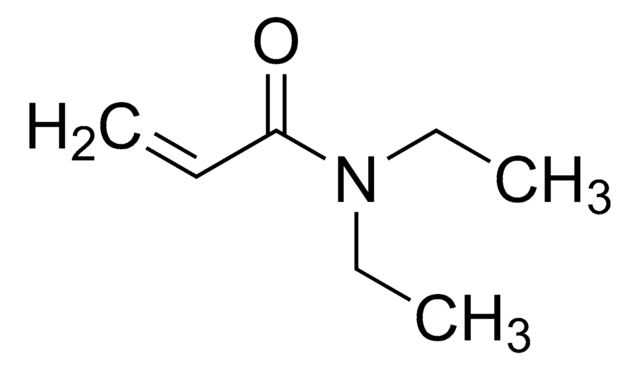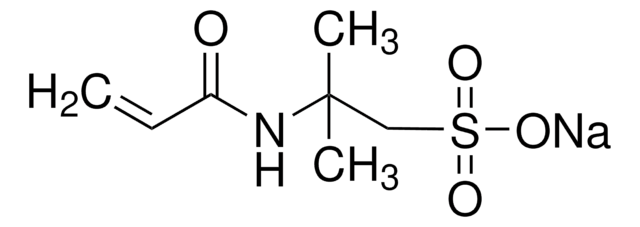448273
4-Acryloylmorpholine
97%, contains 1,000 ppm monomethyl ether hydroquinone as inhibitor
Sinónimos:
1-(Morpholin-4-yl)propenone, 1-Morpholinoprop-2-en-1-one, 4-(1-Oxo-2-propenyl)morpholine, 4-Acryloylmorpholine, Acryloylmorpholine
About This Item
Productos recomendados
Análisis
97%
contiene
1,000 ppm monomethyl ether hydroquinone as inhibitor
índice de refracción
n20/D 1.512 (lit.)
mp
−35 °C (lit.)
densidad
1.122 g/mL at 25 °C (lit.)
temp. de almacenamiento
2-8°C
cadena SMILES
C=CC(=O)N1CCOCC1
InChI
1S/C7H11NO2/c1-2-7(9)8-3-5-10-6-4-8/h2H,1,3-6H2
Clave InChI
XLPJNCYCZORXHG-UHFFFAOYSA-N
Categorías relacionadas
Descripción general
Aplicación
- To synthesize multiblock copolymers via RAFT polymerization. These functional block copolymers find application in the fields of medicine, energy, and nanotechnology.
- To prepare organogel electrode frame via photopolymerization and cross-linking. This can be used to fabricate triboelectric nanogenerators with excellent transparency, stretchability, and interface adhesion.
- For printing thermoplastic 3D tissue scaffolds. ACMO′s water solubility,and remarkably low viscosity, combined with surface oxygen inhibition, promoteswift liquid flow during high-speed open-air printing.
Palabra de señalización
Danger
Frases de peligro
Consejos de prudencia
Clasificaciones de peligro
Acute Tox. 4 Oral - Eye Dam. 1 - Skin Sens. 1 - STOT RE 2 Oral
Código de clase de almacenamiento
10 - Combustible liquids
Clase de riesgo para el agua (WGK)
WGK 2
Punto de inflamabilidad (°F)
259.7 °F - closed cup
Punto de inflamabilidad (°C)
126.5 °C - closed cup
Equipo de protección personal
Eyeshields, Faceshields, Gloves, type ABEK (EN14387) respirator filter
Certificados de análisis (COA)
Busque Certificados de análisis (COA) introduciendo el número de lote del producto. Los números de lote se encuentran en la etiqueta del producto después de las palabras «Lot» o «Batch»
¿Ya tiene este producto?
Encuentre la documentación para los productos que ha comprado recientemente en la Biblioteca de documentos.
Los clientes también vieron
Nuestro equipo de científicos tiene experiencia en todas las áreas de investigación: Ciencias de la vida, Ciencia de los materiales, Síntesis química, Cromatografía, Analítica y muchas otras.
Póngase en contacto con el Servicio técnico















![N-[Tris(hydroxymethyl)methyl]acrylamide contains ≤7% KCl, 93%](/deepweb/assets/sigmaaldrich/product/structures/130/961/5bc6d1a4-a540-4496-9f46-74507af67e21/640/5bc6d1a4-a540-4496-9f46-74507af67e21.png)
